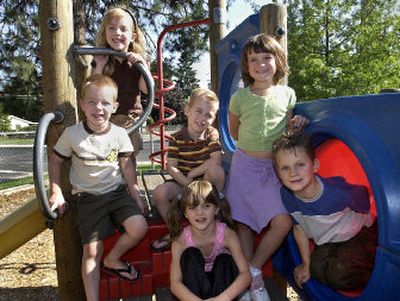Seeing Triple

It’s traumatic enough sending just one tyke off to kindergarten. So imagine how the families of two sets of Spokane triplets must be feeling these last sweet days of summer.
“It’s a definite sign your babies are no longer babies,” Traci Cromwell said wistfully of her 5-year-old triplets’ approaching transition to kindergarten at Hamblen Elementary School.
Parents of triplets – like parents of twins – face concerns unique to families with multiple-birth children. And more parents are confronting these issues, perhaps as a result of modern fertility treatments, which may increase the likelihood of multiples.
March of Dimes statistics show that between 1980 and 1999, the multiple birth ratio jumped 59 percent, from 19 to 30 multiple births for every 1,000 live births in the United States. For older moms, ages 30 to 44, multiple births rose between 62 and 110 percent, with the oldest moms experiencing the highest odds.
So having two sets of triplets entering Hamblen’s student body isn’t too surprising, given the marvels of medical science, said Steve Cromwell, Traci’s husband.
Not only have the Cromwells and Susan Sutton, mom of the other set of triplets heading to Hamblen, each purchased three little backpacks, three pairs of blunt-tipped scissors, three glue sticks, three boxes of No. 2 pencils and three boxes of Kleenex, they’ve had to decide whether to keep them together in one classroom or split them up.
“I’ve done lots of research over the years,” said Traci Cromwell. “For me, kindergarten is just two and a half hours a day, so having them together, I think, is fine.”
Matthew, Katie and Alex are eager to start school. While they have grown up together and are close, they possess very different personalities, Traci Cromwell added.
“Matthew is the natural born leader, the protector,” said his mom. “Katie’s the girliest girl I have ever seen; she loves all things pink, all things princess and all things Barbie. Alex has the funniest and best sense of humor.”
When they’re ready for first grade, Traci Cromwell thinks it will be better for the kids to be in separate classrooms.
“They are so individual in their personalities and learning styles, I just want them to be recognized as individuals and to recognize their own identities as individuals,” she explained.
Meanwhile, Sutton approaches the issue a bit differently.
“I intend to keep them together (in the same classroom) for the first three or four years, unless there’s an obvious issue that needs to be addressed,” she said, adding, “They’re great friends and I wouldn’t want anybody to get hurt feelings if they were separated, like it was personal.”
Her children are a tight group, she said, but they are as different from one another as any siblings might be.
“Ali is the ruler of the roost. People tend to follow her and do what she asks them to do. She’s into her clothes and likes to play dress up and dollies. Tessa is athletic and strong willed. She likes to ride her bike and play games outdoors. Hunter is a builder and a taker-apart kind of guy. He likes to figure things out,” she said.
They’re wound up about starting school with the Cromwell kids, whom they describe as triplets “just like us,” their mother said.
Schools have different policies about classroom placement for multiples. Districts such as Spokane and Central Valley believe decisions should be a collaborative effort involving parents, teachers and school administrators, said spokeswomen from each district.
Don Warner, who’ll be principal at Hamblen this year, called such choices “team events.”
“We try to work with parents, find out their needs, put our heads together and decide what’s good for the children,” he said.
Cindy Jones, whose 9-year-old twins Olivia and Jacob will be fourth-graders at Adams Elementary this year, said she appreciates this flexibility and support from the schools. A twin herself, she can easily relate to her childrens’ experiences.
Her twins were in the same class as kindergartners and first-graders. “In second grade, I requested they be separated,” she said. “It was kind of neat, them being with different teachers and having different techniques. There wasn’t any tattletaling and they developed separate groups of friends.”
Eight-year-old twins Cody and Jordyn Dunne attend Greenacres Elementary School. They’ve always been separated in school, they said. “Otherwise, we’d talk too much,” admitted Cody.
“Since we’re not in the same classroom, we don’t depend on each other. We have to do things ourselves,” his sister added.
Catheleen Schlotter, a school social worker at Spokane Valley’s McDonald Elementary School, said that’s often the case.
“Twins have different personalities and needs. And because of their competitiveness, it’s better for different homework to be going home,” she said.